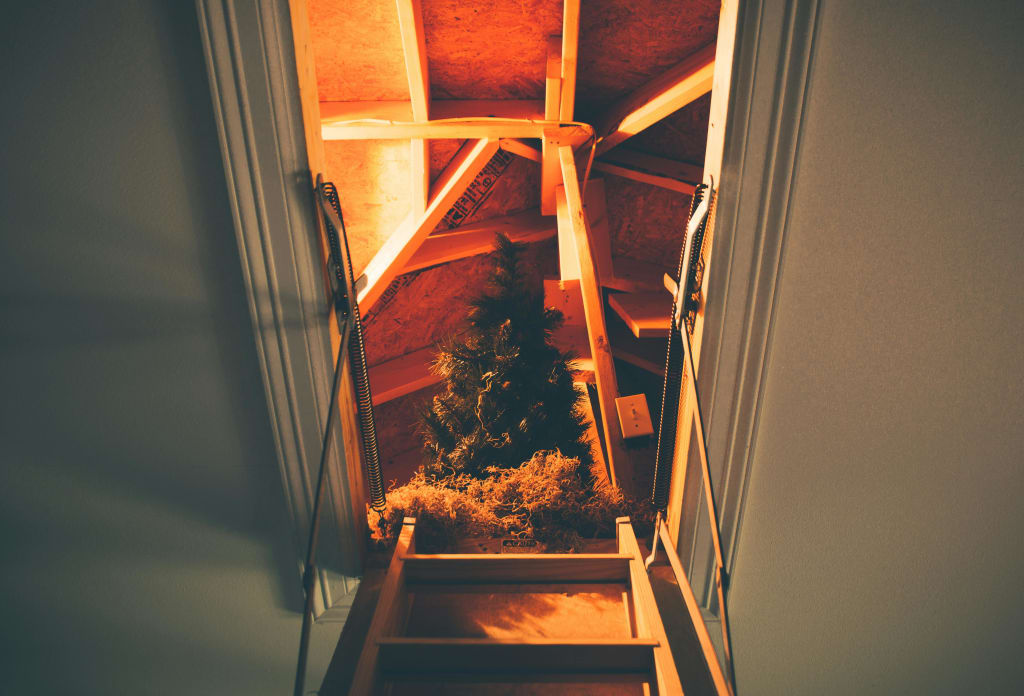How I Beefed up my Attic the Right Way
The order I, a DIY-er, needed to do things and how big I needed to go (or not)

Alright DIY-er, you want to hear my story about me tackling my attic because you are savvy enough to know that if you wear a tuque on your head in winter, you can get away without wearing a jacket - but the reverse is not true. Hot air rises, like a bad boss' ego, so here's how I keep it contained (in my house at least). For you bean counters out there, I will show you what happened to us with the results of my calculations.
The top considerations for attics I have come across - assuming the attic was built well yet isn't big enough to be turned into a loft - are:
- storage
- an entry deck
- air flow
- air sealing
- insulation
When it comes to storage, many are tempted to use their attic space. Why? Bad conditions, you forfeit savings on your heating bill, it's awkward to get to, and it begs the question of why get so enamoured with buying shit. Anyway, there's too much out there to get into the nitty-gritty of why not, so I will that part of your curiosity to those Internet wolves. Besides, we had storage in a finished space under the basement stairs.
The entry deck to your attic (the super-deck) is key if there is enough room for a person to actually crawl or walk around your attic (like mine). After spending a fair amount of time up there sorting things out, I quickly decided to NOT cheap out on wood for the super-deck and had at least one foot of wood all the way around with even more on the side(s) I use when entering the attic.
Next was airflow. Fortunately, there was air coming in through the soffits on three out of four sides of my house. Technically, you should see sunlight peering through the outer edges where the roof meets the house wall since air does need to flow.
I need to pause here because there are materials you can use to have airflow built into the structure of the roof itself. But my house was built in 1960. With real wood of true size (in other words a piece of wood two inches by four inches is actually that size in my house, not the thinner ones available today that are somehow still called a 2x4).
So for my traditional house, air needs to constantly come in through the soffits (the white things you can see on the under-side of your roof from the outside) and then up the inside of the attic to the hot air vents. (I wrote about what happens if you don't have enough vents in your roof in this article, which also includes a photo of baffles and natural lighting you need to have in your attic when its completely empty.) If you are going to load up your attic with insulation, you need a barrier between the inside edge of your roof and the insulation to keep the space for air to flow. That's where baffles come in.
Baffles come in all shapes, styles, and sizes. Wanting to keep my house cool in summer and keep it warm in winter, I tried to find baffles that could do that, too. You won't believe the hack I found - and neither could I, Aluminum foil. What made things even more hilarious in my opinion, was I got a hold of a really big roll of soup can labels with soup details on one side and aluminum foil on the other!!
Why use a super sturdy aluminum foil? The vast majority of baffles out there will require you to staple something to the trusses (the beams of wood holding up your roof). If the aluminum foil is a few inches away from the roof itself, then it will reflect the summer heat back out. In fact, as I was doing this, I noticed a difference of ten degreed Celsius on the side I had completed versus the side I hadn't - and I was up there for a couple weeks (apparently because DIY-ers have nothing better to do).
So I hit two birds with one stone, baffles and heat reflection rather than doing both separately. The one thing I had to calculate, though, was where to put the gap in the baffles. From my understanding, you can't have baffles go all the way up to the top of your attic ceiling. There has to be a good six-inch gap (or more) all the way around. That means you need to know how much insulation you are going to put in your attic (in terms of depth).

Before you even think about attic insulation, sort out air sealing. It will make a much bigger difference. Have you ever worn a hat on a cold and windy day but, but the hat was not that thick and the wind pierced right through it? That's what will happen to your house if you skip this step.
If you can use a water gun, you can air seal your attic. I'm serious. The cost of supplies were about $150 (Canadian dollars). That got me everything I needed:
- super light one-piece zip-up suit,
- air mask with filters,
- headlight,
- a spray gun,
- a big bottle of spray foam,
- a bottle of spray gun cleaner,
- a small bucket, and
- a garbage bag.

The goal is to point and spray a thin line of foam where the edge of the vertical walls meet the attic joists (the structural beams of wood on the floor of the attic). Why do this? In winter, your attic is gonna get freaking cold. Cold air likes to go down...from your attic down your walls and into your house via electric outlets. Ever put your hands near plugs in winter and feel a cool breeze? That is cold air coming from your attic, down the space between the wood and drywall, and out through the electrical outlet. Brrrr. Plug that shit up by air sealing your attic.

The other air leak you have is the entrance to the attic. Please tell me you have more than just a thin piece of wood. And please tell me you don't have a thin piece of whatever thin material all around the entrance with a zipper to make you feel all sheik.
I did a much more solid job. I got a big piece of 4-inch think foam board. I cut it up and made a box without a top (the bottom piece plus one on each of the four sides). On the bottom of the inside of that box, I put some aluminum foil. Yup, then I flipped that box over to cover the entrance such that the aluminum foil reflects the heat back down into the house during winter. I mean, I don't casually spend time in my attic except for repairs, so why heat the attic in winter?
I didn't stop there because I learned something from my fridge...door. Why have that squidgy stuff along the side? Why not just have the door close like any other? To restrict airflow. So I put that around the bottom of the box and fastened it with a few mini bungee cords.

Then I got a thin piece of wood, painted it, and rested it gently in place so you'll never see all the work I put into creating the above photo and beyond.
The last stop is insulation. It's the last thing you do on your attic. The last thing. Why do I say this? Because we decided to put in a bathroom on our upper floor, which means an exhaust fan needs to be installed, which means I have to do work in my attic that is now filled with insulation a solid meter deep at the highest point in our attic.

Hey, I'm a DIY-er, I'm allowed to make one mistake.
Tip: I went to a tradeshow and I spoke with others about having a bathroom exhaust go straight up out of your roof as opposed to horizontal and blowing downwards at one point in your soffits. If it goes straight up, you get heat loss, but the bigger concern is condensation on the outside of that tube, which goes into all the insulation, wood, and drywall in your attic. Can you say water damage? Me no want so me no do.
Anyway, after the air sealing was done, I went ahead and picked my insulation. There are many to choose from, so do your research. I'll leave it at that. Oh, and just make sure no insulation goes into your baffles and only step on solid wood, not drywall. (No need to have either of those be your one mistake since you read this article!)
What was the pay-off of all that attic work? At that time we used gas heating and I compared our consumption the winter before against the winter after all the attic renovations - which were very similar in terms of temperature, temperature drops, and wind storms. We had a 10% decrease in gas consumption (our furnace was the only gas appliance at that point). Before you congratulate me, though, the gas price increase by 30% the winter following the attic renos. Ten percent decrease in consumption, thirty percent increase in price. Made my freakin' day, let me tell you.
But, we had the last laugh. We took part in a home reno program offered by the gas provider whereby if I improved my air sealing (which was easy given it hadn't been done on the house before), they would offer use a chunk of change. The chunk of change amounted to the previous year's gas bill OR the cost of all the materials I used plus the company that filled my attic with insulation plus the energy audit. One way or another, we got our money back and then promptly replaced our furnace (which is a story I have yet to write) and got off of gas completely (which you can read about here).
If, like me, you have a significant other who is into gardening, check out Garden University on Etsy. Appreciate them and who knows, they might not mind it so much when you start your next DIY project.

About the Creator
Richard Soulliere
Bursting with ideas, honing them to peek your interest.
Enjoyes blending non-fiction into whatever I am writing.






Comments (1)
I’m scared of my attic! Great job!